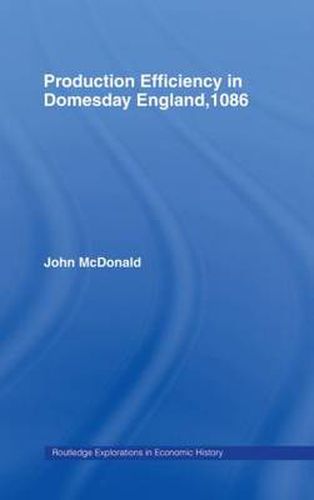Readings Newsletter
Become a Readings Member to make your shopping experience even easier.
Sign in or sign up for free!
You’re not far away from qualifying for FREE standard shipping within Australia
You’ve qualified for FREE standard shipping within Australia
The cart is loading…






This fascinating study uses Domesday book data and Management Science methods to examine manorial production efficiency in Medieval Essex in 1086. This book reveals unexpected facts about economic history. Some of the questions raised and unanswered by this study include: * Which tenants-in-chief ran efficient estates? * How was productivity affected by soil type, the size of the estate, the technology and the institutional framework of the time, or the proximity of a market centre? * Which inputs made the major contribution to the net value of output? * Did slaves make a greater contribution to the manorial systems, which discouraged mobility of inputs, on the system of production, input productivities and total output produced? Contrary to the accepted view that Normans ran their estates haphazardly and according to the local custom a more rational organized economic system was in fact in place. This efficiency analysis suggests that the feudal and manorial systems imposed a substantial cost; Domesday estates, John McDonald, reveals were run at similar efficiency levels to comparable production units in more modern economies. This book is a remarkable contribution to economic history and medieval studies; it will be of great interest to economists, management scientists, medievalists and anyone involved with Domesday studies.
$9.00 standard shipping within Australia
FREE standard shipping within Australia for orders over $100.00
Express & International shipping calculated at checkout
This fascinating study uses Domesday book data and Management Science methods to examine manorial production efficiency in Medieval Essex in 1086. This book reveals unexpected facts about economic history. Some of the questions raised and unanswered by this study include: * Which tenants-in-chief ran efficient estates? * How was productivity affected by soil type, the size of the estate, the technology and the institutional framework of the time, or the proximity of a market centre? * Which inputs made the major contribution to the net value of output? * Did slaves make a greater contribution to the manorial systems, which discouraged mobility of inputs, on the system of production, input productivities and total output produced? Contrary to the accepted view that Normans ran their estates haphazardly and according to the local custom a more rational organized economic system was in fact in place. This efficiency analysis suggests that the feudal and manorial systems imposed a substantial cost; Domesday estates, John McDonald, reveals were run at similar efficiency levels to comparable production units in more modern economies. This book is a remarkable contribution to economic history and medieval studies; it will be of great interest to economists, management scientists, medievalists and anyone involved with Domesday studies.